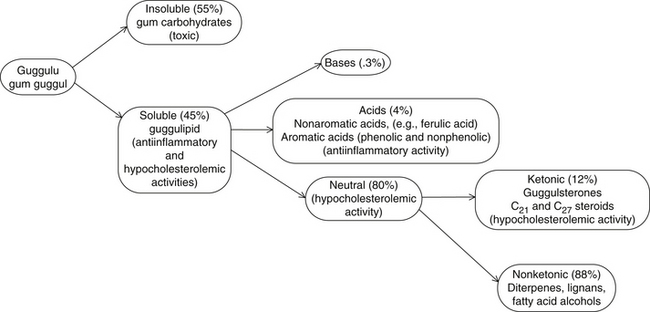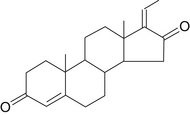Chapter 81 Commiphora mukul (Mukul Myrrh Tree)
Commiphora mukul (family: Burseraceae)
 General Description
General Description
Commiphora mukul, a small, thorny tree that grows 4 to 6 feet tall, is native to Saudi Arabia and India. In its natural setting, the tree remains essentially free of foliage for most of the year. Its bark is ash colored and comes off in rough flakes, exposing the under-bark, which also peels off. When injured, the tree exudes a yellowish gum resin that has a balsamic odor. This oleoresin is referred to as “gum guggul” or “guggulu.” This resin is used for medicinal purposes. When tapped during the winter, the average tree yields 1.5 to 2 lb of resin.1
 Chemical Composition
Chemical Composition
Guggulu contains a mixture of diverse chemical constituents that can be separated into several fractions.1 The first step in the fractionation process involves mixing guggulu with ethyl acetate to yield soluble and insoluble fractions (Figure 81-1). The insoluble fraction, containing the carbohydrate constituents, is regarded as toxic and is the major reason why extracts of the soluble portion are preferred to crude gum guggul for medical use. The insoluble portion has no demonstrable pharmacologic activity other than toxicity.1
In contrast, the soluble portion possesses significant cholesterol-lowering and antiinflammatory activity. The soluble portion can be further separated into base, acid, and neutral fractions. The neutral portion possesses almost all of the cholesterol-lowering activity, whereas the acid portion possesses the anti-inflammatory components.1
On further purification of the neutral portion, it was determined that the ketone fraction contains the most potent cholesterol-lowering components. The ketone fraction is composed of C21 or C27 steroids, with the major components being Z- and E-guggulsterone (Figure 81-2). These compounds are considered the major active components of gum guggul and its extracts.1
For medicinal purposes, a standardized extract known as guggulipid, which is standardized to contain a minimum of 50 mg of guggulsterones per gram, is regarded as the most beneficial in terms of safety and effectiveness.1,2 In addition to guggulsterones, guggulipid contains various diterpenes, sterols, esters, and fatty alcohols. These accessory components appear to exert a synergistic effect.1,2
 History and Folk Use
History and Folk Use
Guggulu is a highly valued botanical medicine in the Indian system of medicine, Ayurveda. It is included in formulas for various health conditions, including rheumatoid arthritis and lipid disorders. The classic Ayurvedic medical text, the Sushruta Samhita, describes in detail the usefulness of guggul in the treatment of obesity and other disorders of fat metabolism, including “coating and obstruction of channels.”1,2
Inspired by this description, researchers began examining, in well-designed scientific studies, the clinical effectiveness of gum guggul and its extracts in disorders of lipid metabolism—specifically, its ability to lower cholesterol and triglyceride levels and promote weight loss. This research resulted in the development of a natural cholesterol-lowering substance that is safer and more effective than many cholesterol-lowering drugs, including niacin. Guggulipid was granted approval in India for marketing as a lipid-lowering drug in 1986.1,2
 Pharmacology
Pharmacology
Lipid Disorders
Numerous studies in humans and animals showed that gum guggul (both crude and purified alcohol extract),3–7 its petroleum ether extract (referred to as fraction A),8–11 and guggulipid (standardized ethyl acetate extract)12,13 all exert effective lipid-lowering activity. All lower both elevated cholesterol and triglyceride levels. The effect on cholesterol is particularly beneficial, as guggul lowers very low-density lipoprotein (VLDL) cholesterol and low-density lipoprotein (LDL) cholesterol, while simultaneously elevating high-density lipoprotein (HDL) cholesterol, thus offering protection against heart disease due to atherosclerosis.
Guggul preparations appear most indicated in type IIb (increased LDL, VLDL, and triglycerides) and type IV (increased VLDL and triglycerides) hyperlipidemias. Preliminary human clinical trials using guggulipid found that cholesterol levels showed typical reductions of 14% to 27% in total cholesterol levels in a 4- to 12-week period, whereas triglyceride levels dropped from 22% to 30%.12–14 However, a larger double-blind study did not show that either of two doses of a standardized guggul extract (guggulipid, containing 2.5% guggulsterones) lowered LDL cholesterol levels in healthy adults with hyperlipidemia.15 Subjects received either standard-dose guggulipid (1000 mg), high-dose guggulipid (2000 mg), or matching placebo three times daily for 8 weeks. LDL cholesterol levels decreased by 5% in the placebo group. Both standard-dose guggulipid and high-dose guggulipid raised levels of LDL cholesterol by 4%, respectively. There were no significant changes in levels of total cholesterol, HDL cholesterol, triglycerides, or VLDL cholesterol in response to treatment with guggulipid in the intention-to-treat analysis. Although guggulipid was generally well tolerated, six participants treated with guggulipid developed a hypersensitivity rash compared with none in the placebo group. These results call into question the clinical effectiveness of guggulipid despite plausible mechanisms of action.
In vitro studies showed that the primary mechanism of action involves guggulsterones acting as an antagonist ligand for the farnesoid X receptor (FXR) and upregulating the bile salt export pump. As a result, guggulsterones promote the conversion of cholesterol to bile acids and increase the uptake of LDL cholesterol from the blood by the liver.14,16–19 Another possible action of guggulsterones in affecting lipid levels is their ability to stimulate thyroid function.20,21
Gum guggul and guggulipid were also shown to prevent heart damage by free radicals and to improve heart metabolism.9,14 Gum guggul and its extracts have a mild effect in inhibiting platelet aggregation and promoting fibrinolysis, implying that it may also prevent the development of a stroke or embolism.2,14
Stay updated, free articles. Join our Telegram channel

Full access? Get Clinical Tree




